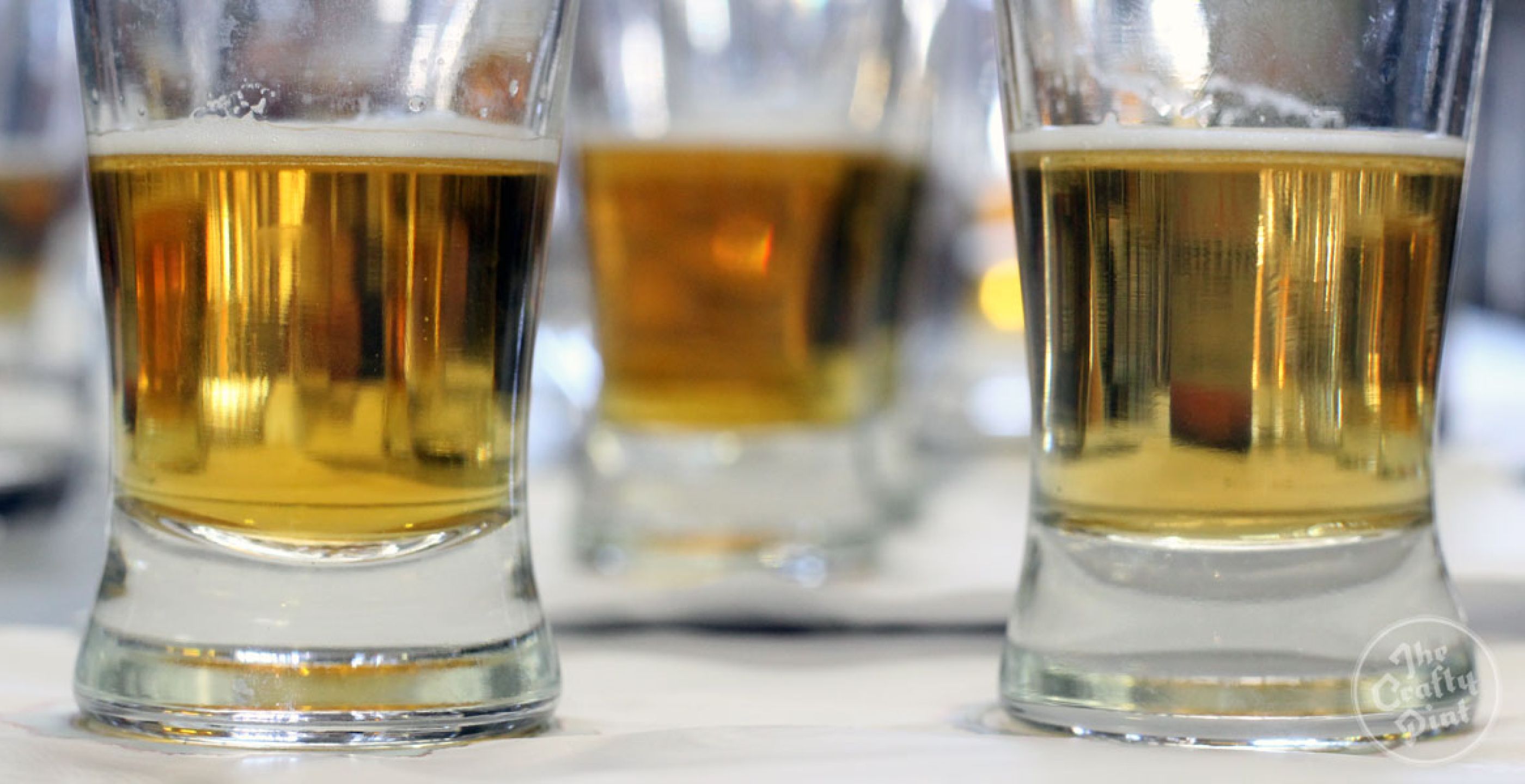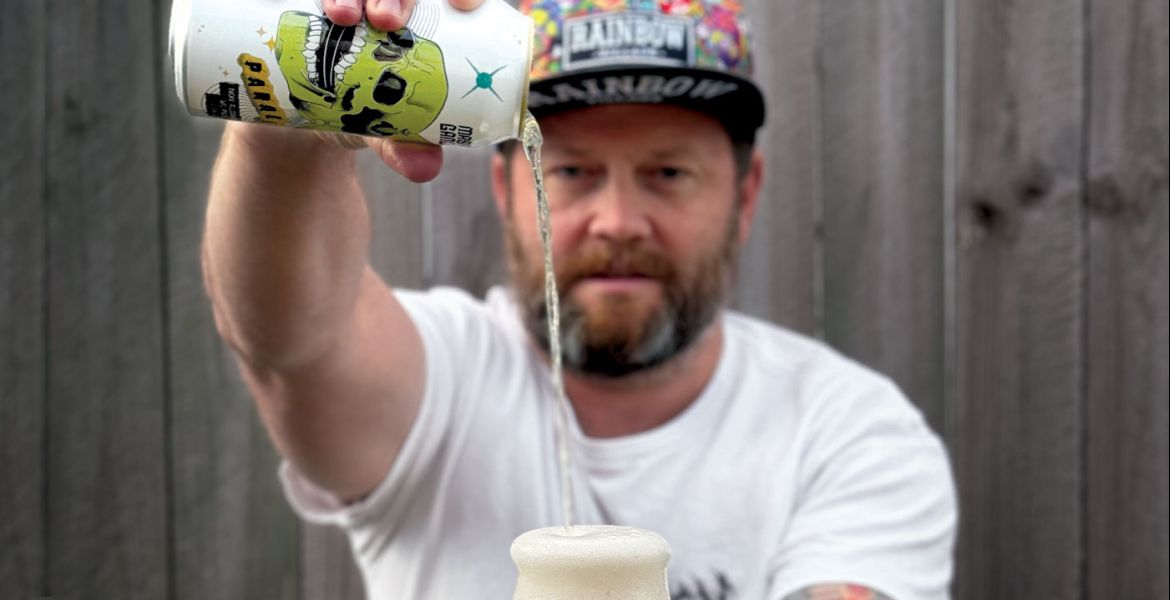Tomorrow, we'll publish the results of the final blind tasting of the year. We lined up a collection of mostly Australian pale lagers, a style that's growing in popularity among smaller brewers.
Before we reveal who came out on top, Resident Beer Scholar Chris Brady delves into beer's multifarious past for another of his colourful explorations of a beer style.
“Shouting, lager lager, lager!”
We’ve all pogoed around a dance floor shouting that neat little one-liner, haven’t we? Or perhaps it was just those of us who were young and jubilant enough in 1996 when Underworld’s banging Born Slippy seeped from the closing credits of Trainspotting onto the playlists of pretty much every DJ on the planet, whether they were playing the local Ritzy or to thousands at Pacha.
Either way, lager has long been unjustly tarred with the clumsy brush strokes of boozy yob culture. Lager’s only crime was being approachable enough to be drunk in vast quantities by, well, anyone with a mouth. Yet lager has a rich story featuring industrial espionage, improbably well-travelled yeast cultures and, above all, zen-like stillness in the crystalline quiet of alpine caves.
At the broadest level of categorisation, beer can be roughly divided into two large groups: ale and lager, with the latter being the cheeky young upstart to the old grandfather ale. The only meaningful difference between lager and ale is the type of yeast used. Ale yeasts, which can be found in the wild, are known as Saccharomyces cerevisiae. These yeasts ferment best at warm temperatures of around 20C. However, lager brewers use Saccharomyces pastorianus (AKA Saccharomyces carlsbergensis after the Carlsberg brewery lab where it was first isolated), which does its best work down in the low teens with some strains happily braving single digit temperatures.
Our thoughtful ancestors began the long trek towards tasty modern beer many millennia ago in what is now Southern Iraq. These early beers would have been mixed ferments of wild yeasts and bacteria that probably produced exceedingly mixed results. However, the mood-altering effects made the struggle worthwhile. Eventually, brewers realised that if they scooped the foam from a fermenting brew then this could be used to ferment a subsequent batch. In this way early brewers were unwittingly putting selective pressure on yeast by only using the frothy, healthy yeast at the top of the brew. Fast forward some 4,500 years and brewers across Europe are brewing year-round with variable results.
Up until this point, the beers could be defined as ales, as lager yeast had yet to make an appearance.
The first (brown) lagers & natural selection for cold fermentation
The first lagers emerged in Western Europe, most notably Germany, and had a lot in common with ales of the time: they were brown and most likely smoky. This was due to the use of dark malts that had been kilned using hot wood fires as a heat source.
The brewers of these dark lagers, without the benefits of modern scientific knowledge – indeed without any knowledge that yeast existed – were brewing mixed ferments of ale yeasts along with wild yeasts and bacteria from the environment. Some of these agents of fermentation flourished in warmer conditions, others in cooler conditions.
Without the benefits of refrigeration, beers brewed in the warmer months tended to be less stable and more prone to infections as warmer conditions result in more microbial activity and faster spoilage of perishable foods. On the other hand, winter-brewed beers tended to last longer as yeasts that were able to grow at cold temperatures could easily outcompete sluggish bacteria such as the souring Lactobaccillus that prefer to work at much higher temps.
 The variances in stability hadn’t gone unnoticed as, in Southern Germany in 1553, Duke Albrecht V of Bavaria (pictured), who’d obviously had a gutful of foul, infected beer, declared that brewing was only to take place in the cooler months, between St. Michael’s Day (Sept 29) and St. Georges Day (April 23).
The variances in stability hadn’t gone unnoticed as, in Southern Germany in 1553, Duke Albrecht V of Bavaria (pictured), who’d obviously had a gutful of foul, infected beer, declared that brewing was only to take place in the cooler months, between St. Michael’s Day (Sept 29) and St. Georges Day (April 23).
With modern knowledge of yeasts it is tempting to assume that, because the beers were a microbial menagerie, the ales brewed in summer slid into being lagers during the winter due to the shifting yeast populations in the slurry that was used for repitching. Therefore, by essentially enforcing a program of cold-weather brewing, Albrecht V set brewers on a path to the development of modern lager as it meant that all beer became cold fermented.
This decree also meant that all beer supplies for the summer had to be stockpiled in suitably icy caves to await summer drinking, and this is where lager gets its name: from the German verb Lagern, meaning to store.
It is around this time that lager yeasts are thought to have developed. Amazingly, lager yeast is not found in the wild but seemingly appeared as if by magic in cold Germanic ferments.
Lager yeast is a hybrid that until quite recently was thought to comprise ale yeast and Saccharomyces bayanus, a wine yeast that can ferment at low temperatures. However, recent DNA sequencing has jettisoned the S. bayanus theory and shows that, along with ale yeast, lager’s mystery progenitor is in fact a wild yeast, S. eubayanus that is endemic to the chilly Patagonian mountains of Argentina and Chile, thriving in the sugar-rich galls that form on beech trees.
These wild yeasts have yet to be found in Europe so the theory is that they were taken to Europe aboard trading ships, embedded in items such as food stuffs or timber and eventually hybridised with ale yeasts in German beer to form a proto-lager yeast which was better able to ferment at cold temperatures.
This yeast was then then put under selective pressure by brewers re-pitching over and over, eventually developing into modern lager yeast.
The first pale lagers
So far so good, but lager is still brown. Pale lager was yet to be born.
The breakthrough came in 17th century Britain with the advent of coke (the smokeless fuel, not the yuppie nose-candy) that enabled maltsters to produce lightly kilned pale malts, which in turn made pale beers.
By the 18th century, British pale ales were all the rage, especially when drunk from new-fangled glass vessels which made the pale sparkling liquid seem all the more appealing. It wasn’t too long before the European lager brewers wanted to have a crack at making their own pale beers and depending on which version of history you prefer, European brewers were either inspired by their British brewing brothers or pinched their ideas by stealth.
The theft story seemingly holds water on reading the accounts of two travellers, Gabriel Sedlmayr II of Munich’s Spaten Brewery, and Austrian brewer Anton Dreher. In 1833, the dastardly pair visited various British breweries and, using a tricked-up gentlemen’s walking cane that featured a hollow interior, managed to exit said breweries with samples of yeast, wort or anything else that took their fancy.
Regardless of the method, it is the brewers of Pilzn, Bohemia, Czech Republic (pictured below), who are generally credited with creating the world’s first pale lager in 1842. It was a hoppy brew with a fine aroma due to the use of local Czech hops. This beer came to be called Pilsner Urquell.
It wasn’t long before the Germans* produced their own Pilzn-style beers (Bitburger Pils being one of the earliest examples). From here, the Germans dropped the alcohol and bitterness slightly to create the super-drinkable helles (meaning “pale”) lager. Add to this year round lager brewing thanks to the advent of refrigeration in the 19th century and the stage was set for pale lager’s world domination.
In terms of what you should expect in a classic pale lager, the clue to the colour is in the title: Munich helles typically pour a clear gold. Flavour and aroma wise, they combine smooth, sweet, grainy malts with a touch of floral, spicy or herbal hops and a gentle dry finish.
Industrial lagers
Today, something in the region of 90 percent of the world’s beer production is lager and, obviously, for the most part these are produced by the world’s mega-breweries. As unbelievable as it might seem at first glance, these beers share a common ancestry in that they have all evolved from those first helles and pilsner beers of Bohemia and Bavaria.
Modern technologies such as refrigeration, filtration and centrifugation have been instrumental in allowing ever-decreasing lagering times which allow the big brewers to pump out product in with an incredibly quick turnaround; a massive difference from the weeks and even months of lagering that used to be commonplace.
Craft lagers
Craft brewers are often at the vanguard of new hybrid styles, unusual ingredients and threshold-shifting rates of hopping. However, they can also pay homage to the old lager ideals of subtlety, delicacy and balance, with many craft brewers producing beers that could be quaffed with ease in a German beer garden without fear of stripping the enamel off your teeth.
Of course, craft beer wouldn’t be craft without a little envelope pushing so as with ales, we are seeing lagers featuring new world hops or assertive dry-hopping. There are even a few IPA-style lagers out there, but these are the outliers in a field that seems to show a dignified restraint. And why not? Craft lager is in many ways the ultimate gateway craft beer.
Altogether now: “SHOUTING! LAGER, LAGER, LAGER!”
Classic examples
Not too many German helles make it to these shores in packaged form, but you may be able to find a couple of classics, Löwenbräu Original and Weihenstephan Original, although the latter, in particular, seems to sell out fast when stock does arrive.
As for Australian pale lagers, well, you'd best see how our blind tasting went when we publish the results tomorrow.
NB: As best as possible, we only included pale lagers (plus a couple of "New World" takes on the pale lager style) in the tasting; no pilsners, no dark lagers, no schwarzbiers, in order to keep numbers to a manageable level.
About the author: Chris Brady hails from the north of England but migrated south nearly two decades, moving from home brewing to pro brewer in 2013. To read his past Drinking in Style articles, head here.
Image of Albert V of Bavaria pilfered from here. Image of Pilzn taken from the Pilsner Urquell website.
* This article originally said "Bavarian" here instead of "German", but a reader who grew up near Bitburg pointed out it's a bloody long way from Bavaria. And, indeed, there were early German takes on the pilsner created in other parts of the country too.


















